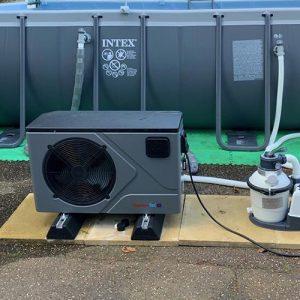 A pool heater works by using various methods to raise the temperature of the water in a swimming pool, making it more comfortable for swimming, especially in colder weather. There are several types of pool heaters, but the most common types are gas heaters, electric heaters, and heat pumps. Here’s a general overview of how each type works:
A pool heater works by using various methods to raise the temperature of the water in a swimming pool, making it more comfortable for swimming, especially in colder weather. There are several types of pool heaters, but the most common types are gas heaters, electric heaters, and heat pumps. Here’s a general overview of how each type works:
- Gas Heaters: Gas pool heaters use natural gas or propane to generate heat. The heater contains a combustion chamber and a heat exchanger. Here’s how they work:
- Gas Supply: Natural gas or propane is supplied to the combustion chamber of the heater.
- Combustion: The gas is ignited, and the combustion process generates heat.
- Heat Exchange: The heat generated by combustion is transferred to the water in the heat exchanger. The heat exchanger is a coil or tube system that allows the pool water to circulate around it.
- Circulation: The pool water flows through the heat exchanger, absorbing heat from the combustion process.
- Return: The heated water is then returned to the pool, raising its overall temperature.
- Electric Heaters: Electric pool heaters use electric resistance elements to generate heat. They are less common than gas heaters due to their higher operating costs. Here’s how they work:
- Electric Element: The heater contains one or more electric heating elements, similar to those found in electric water heaters.
- Electricity Supply: Electricity is passed through the heating elements, which have high electrical resistance.
- Heat Generation: As electricity flows through the elements, they become hot due to resistance, generating heat.
- Heat Transfer: The heat generated by the elements is transferred to the water as it circulates through the heater’s plumbing and coils.
- Circulation and Return: The heated water is then returned to the pool, warming it.
- Heat Pumps: Heat pumps are energy-efficient pool heaters that work by transferring heat from the surrounding air to the pool water. They don’t generate heat directly but use electricity to move heat from one place to another. Here’s how they work:
- Evaporation: A refrigerant inside the heat pump evaporates at a low temperature, absorbing heat from the surrounding air.
- Compression: The vaporized refrigerant is compressed, which raises its temperature further.
- Condensation: The hot, pressurized refrigerant releases its heat to the pool water as it condenses back into a liquid state.
- Heat Transfer: The pool water flows through the heat exchanger, where it absorbs the heat from the refrigerant.
- Circulation and Return: The warmed water is returned to the pool, raising its temperature.
Each type of pool heater has its advantages and disadvantages, including factors like initial cost, operating cost, efficiency, and environmental impact. When choosing a pool heater, consider these factors along with the specific requirements of your pool and climate.
